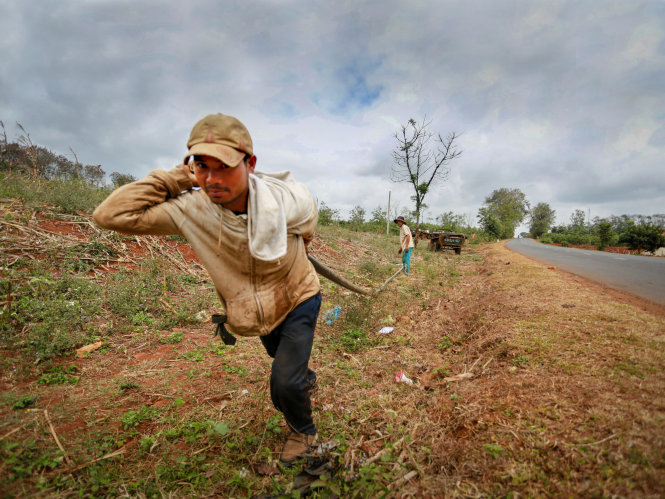Farmers in Dak Lak province in Vietnam’s Central Highlands are now threatened with losing their entire rice and coffee crops to severe drought.
The unrelenting heat has caused 599 reservoirs of Dak Lak Provice in the Central Highlands to reach critical condition.
Of these, 118 gave already dried up completely, three times as many as last year, with severe consequences for local agriculture, said local officials in a press conference held by the provincial People’s Committee on Monday.
Bui Hong Quy, spokesperson for the People’s Committee, said that provincial pumping stations could not supply enough water for planting and farming as the water level in local rivers was alarmingly low during the first quarter of the year.
Many areas are also lacking in underground water due to the ongoing climatic conditions, Quy added.
A provincial statistics report said that 36,961 hectares of planting area have been hit by the drought, estimating the financial damage at VND1.110 billion (US$49,783).
About 2,000 hectares of coffee plantation in Cu M’gar District have been devastated by water scarcity, the report said.
“We have dug a 10 meter well near the stream for watering the coffee crops, but it is worthless as the water is insufficient for the crops to endure the heat,” Y Thum, a coffee grower and his family from Ea Tar Commune, Cu M’Gar District, worriedly said.
With the exception of M’Drak District, all provincial districts have experienced a water shortage, including 21,000 households that lack water for daily use, the report added.
Y Thon Nie, chairman of the Ea Tar Commune People’s Committee, admitted that if the harsh weather continues, hundreds of hectares of coffee plantations will suffer heavily.
A water supply company in Buon Ma Thuot City has recently cut 30 percent of its supply with plans to cut that number to half in the near future.
To counter such a predicament, local authorities have enacted several measures including managing and controlling water sources for plantation, building anti-drought pumping stations in rivers of several provincial districts, including Lak, Krong Bong, Krong Ana, Cu Kuin, Ea Kar, and more.
Pham Quang Muoi, chief of agriculture and rural development of Cu M’gar District, said that the district has supported locals to dig five wells in three communes, including Ea Que, Ea Tar, and Ea Mroh.
“In March this year, 66 reservoirs in the district dried up, even Buon Yong Reservoir, which has a 17 million cubic meter capacity, meaning 10,000 hectares of plantation area will confront water shortages,” Muoi emphasized.
Meanwhile, 23 reservoirs, along with streams in the Ea H’leo District were dry of water, said one local official, adding that the district’s People’s Committee had supported locals to dig wells for irrigation and for daily use.
“Rice will not grow without water, meaning that my family may not have enough food,” Y Luoi Nie Kdam, a rice grower from Ea Bong Commune, Krong Ana District, said while searching for water sources for his crops.
“I just hope that the government will provide us with rice and vegetables,” he said.
Binh Dinh, a province in south-central Vietnam, has recently stated that water levels in its reservoirs had dropped rapidly, leaving several provincial districts suffering from a poor harvest.
The severity of drought and extreme weather conditions linked to El Niño looks set to worsen across the country in April, as predicted by Vietnam’s National Center for Hydro-Meteorological Forecasting at a weather outlook forum held on Monday last week.
El Niño is characterized by unusually warm ocean temperatures in the Equatorial Pacific, according to the Pacific Marine Environmental Laboratory of National Oceanic and Atmospheric Administration (NOAA).
The phenomenon occurs irregularly at intervals of 2-7 years, although the average is about once every 3-4 years, lasting 12-18 months, NOAA said on its website.
The 2016 El Niño is predicted to be the strongest on record and is likely to cause extreme weather conditions across the globe, APDC’s News reported.
Like us on Facebook or follow us on Twitter to get the latest news about Vietnam!





















































